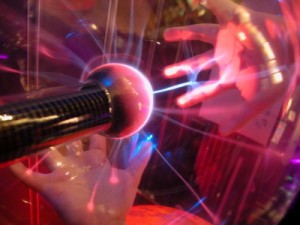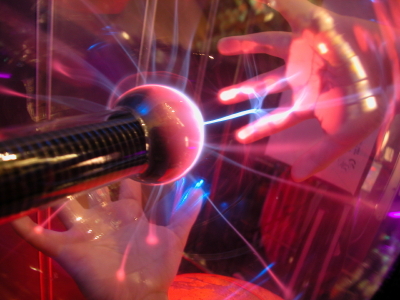 Sometimes I’m lucky just to get my teeth brushed in the morning, let alone design an experiment that illustrates Einstein’s photoelectric effect for my 7-year old son. Luckily, though, YOU don’t need to reinvent the wheel (or the light bulb), because here’s a quick list of cheap and easy experiments that really drive home the basic principles in physical science.
Sometimes I’m lucky just to get my teeth brushed in the morning, let alone design an experiment that illustrates Einstein’s photoelectric effect for my 7-year old son. Luckily, though, YOU don’t need to reinvent the wheel (or the light bulb), because here’s a quick list of cheap and easy experiments that really drive home the basic principles in physical science.
I was thinking of titling it Quality Science in a Hurry on a Shoestring Budget. But what do you think?
[am4show have=’p8;p9;p11;p38;p72;p92;’ guest_error=’Guest error message’ user_error=’User error message’ ]
Higher pressure always pushes: Blow hard over the top of a sheet of paper and watch it fly up to the horizontal. (This is the basic principle in all aerodynamics.)
Like charges repel; opposites attract: Rub your head with a balloon and hold the charged balloon near your head so the positively charged hair sticks to the negatively charged balloon. (Maxwell’s equations.)
Moving charges have magnetic and electric fields: Wrap wire around a nail and connect to power to create a simple electromagnet that can pick up paper clips. (Maxwell’s equations.)
Light travels like a wave but interacts like a particle: Wave: Grab red, green, and blue-tinted flashlights and make shadow puppets on a white wall. Or dab two fingers into a pond of still water and watch the waves interfere with each other. Particle: Charge a glow-in-the-dark object with a camera flash. The energy in (flash) causes the electrons to bump into a higher orbit, but when the flash shuts off, the electrons relax back down to their regular state and emit a photon (in a different wavelength, or color of light… which is the color of your glowing object)…or use a homemade electroscope and hit it with both a red light, then a blue. You’ll find that the red light doesn’t knock the electrons out of orbit (and cause the two foil strips to separate), but the blue certainly does! (Duality principle of light.)
Three states of matter: solid, liquid, and gas: Grab a can of soda. The tin can is the solid, the drink is the liquid, and the bubbles are the gas.
In a system, Stuff In equals Stuff Out: Energy in = Energy out: a marble rolling down a hill. The amount of energy the marble had while at rest at the top of the hill (potential energy) turns into kinetic energy while it zips to the bottom. Momentum in = Momentum out: Place your thumb partway over the end of a garden hose. The water shoots out faster because the same amount of “stuff” has to pass through the exit. When the exit area decreases, less mass can pass through at one time, so the velocity increases. (These are the basic conservation laws: conservation of every, conservation of momentum, conservation of mass.)
Objects at rest stay at rest unless acted upon by an external force: Place an object on the floor and wait very carefully for it to move on its own. Ready for more action? Kick it… and there’s your external force. (This is the first law of physical motion.)
For every action, there is an equal and opposite reaction: Hold a balloon between your fingers and let it go. Note which way the air inside the balloon goes relative to the balloon itself initially. (This is the third law of physical motion.)
Four fundamental forces of nature: strong, weak, gravitational, and electromagnetic: The protons and neutrons on an atom are glued together via the strong force (which is broken when you dump salt into water and measure the temperature increase). Gravitational forces happen every time you throw a ball. Make the electromagnet mentioned above experiment to demonstrate electromagnetic forces. (Skip the weak force for now.)
Heat flows from hot to cold: Leave a cup of hot coffee out on the table. Does it heat up or cool down after 5 minutes? (This has to do with the second law of thermodynamics.)
For the Ideal Gas Law: When temperature increases, pressure and volume increase: Blow up a balloon and stick it in the freezer. When volume decreases, pressure increases – Connect two syringes together with tubing and press one plunger.[/am4show]


Wonderful! So glad you enjoyed it! Ready for more…?
Thanks so much for the summer e-camp! My son has really enjoyed to robot, chemstry and electonics sections!
Jennifer Alfred wrote: “I was wondering where the separate section of advanced activities for older kids would be; the section for 13-17 year olds. Thanks for your time!”
Yes, the activities for the all ages of kids are all mixed together during the summer, but in the Fall, there will be a separate section just for the older kids. This week, for example, has the advanced Alien Detector project int he bonus section. Hope this helps!
Hello! In your e-mail telling us about the summer e-camp you said,
“What ages is the school year e-science program for?
It is appropriate for kids ages 7 through 17 years. There is a separate section of advanced activities for older kids. Age appropriate material is given for each age group.”
I was wondering where the separate section of advanced activities for older kids would be; the section for 13-17 year olds. Thanks for your time!
Jennifer
Veronica Cable wrote: “How long will we be able to access the files for (videos from the 5 weeks and all the written explanations)? I think we will be behind (we already are!) and won’t keep the schedule…”
Good question – as long as you remain a member, you’ll have access to all the content website. In the fall, we’ll be adding a LOT more information that has more of an ‘academic’ feel in addition to the projects and explanations already posted (it’s the same sort of thing, but with textbook reading to complement the principles we’re working with, quizzes and worksheets, etc). But the summer eCamp stuff will still be on the website for a long time.
Again, you do not NEED to complete ALL that we post here. Our goal is to get your student crazy-wild about science. Be clear about what YOUR goal is for this program, and then use what you need to fulfill your goal.
How long will we be able to access the files for (videos from the 5 weeks and all the written explanations)? I think we will be behind (we already are!) and won’t keep the schedule…